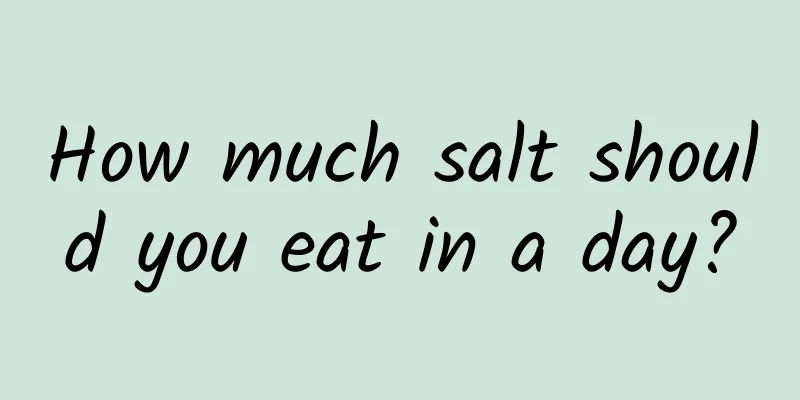How much salt should you eat in a day?

|
This is the 2870th article of Da Yi Xiao Hu Why do we eat salt? The main component of table salt is sodium chloride, which gives us the superficial feeling of "salty". Most Chinese dishes are salty as the basic flavor, and it is the table salt that allows us to enjoy delicious food. The sodium element in sodium chloride is an indispensable chemical element in our body. We have about 6200-6900 mg of sodium in our body. Sodium is widely present in various tissues and organs in the body, regulating the body's water content, enhancing neuromuscular excitability, maintaining acid-base balance and normal blood pressure. There is danger in saltiness Epidemiological surveys on hypertension have confirmed that the blood pressure level and prevalence of hypertension are closely related to salt intake. The prevalence of hypertension in the north is higher than that in the south, and the average blood pressure in rural areas is higher than that in cities. The salt intake is consistent with this, which is also higher in the north than in the south, and higher in rural areas than in cities. Intervention treatment for clinical hypertension has confirmed that when salt intake increases, blood pressure rises. People over 50 and those with family history of hypertension are more sensitive to changes in salt intake. If the salt in the diet increases or decreases, the blood pressure will change accordingly. A high-salt diet can also change the pattern of high blood pressure during the day and low at night, making it high during the day and high at night, greatly increasing the risk of cardiovascular and cerebrovascular diseases. The blood pressure of overweight and obese people is more sensitive to salt. How much salt should you eat in a day? The sodium needed by the human body mainly comes from food and drinking water. Salt, soy sauce, monosodium glutamate, sauces and pickles, pickled products, etc. can provide more sodium, and meat and vegetables can also provide a small amount of sodium. The normal adult needs 2200 mg of sodium per day. The food consumed by an average adult on a daily basis contains about 1000 mg of sodium, and the sodium required from salt is about 1200 mg. Therefore, based on the actual daily food intake, 3 grams of salt can basically meet the body's sodium needs. Due to people's dietary habits and taste preferences, the salt intake is far more than 3 grams. Of course, it is difficult to follow dogma in daily life, and we still need to consider factors such as habits, customs, and preferences. Here, the Shanghai Center for Disease Control and Prevention recommends that healthy adults consume 5 grams of salt a day (including the salt in soy sauce and other foods). Author: Shanghai Center for Disease Control and Prevention Jenny Zhu |
<<: What should you eat if you have high blood pressure? Save these 4 suggestions
>>: What material is good for yoga mats? Differentiate between the front and back of yoga mats
Recommend
I have a bad stomach, a loss of appetite, feel full after eating a little, and often have acid reflux. What should I do?
A friend of Huazi said that she had a bad stomach...
Is the 23-week placenta level 1 too much?
During pregnancy, if pregnant women eat well, the...
How long will it take to give birth if you have spotting before giving birth?
Women in the perinatal period are all in a relati...
When is the best time to do fallopian tube insufflation?
If a woman has blocked fallopian tubes, she can c...
Swelling of the milk ducts
The swelling of the mammary ducts is caused by ba...
How long after induced abortion can I have sex?
After induced abortion, female friends must pay a...
Belly button pain in 6 months of pregnancy
Important reminder: When pregnant, pregnant mothe...
What should pregnant women do if they don't have bowel movements for a few days?
Although pregnancy is a relatively special stage,...
Family planning and contraceptive knowledge class
The family planning policy affects daily life, an...
Why do I fart a lot after giving birth?
Many mothers who have just given birth will feel ...
Wisdom teeth cannot be removed during menstruation
It is best for female friends not to have wisdom ...
How to treat chronic pelvic inflammatory disease and adnexitis?
We all know that women have a menstrual cycle eve...
Why do companies like to form cliques? What should we do if there are cliques in the company?
Wherever there are people, there will be conflict...
Is foot bathing good for the ovaries?
The ovaries are important reproductive organs for...
What are the exercises for girls to grow taller and longer legs?
It is definitely every girl's dream to grow t...









